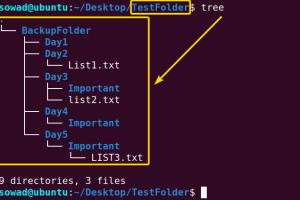Mastering the Linux Find Command: A Comprehensive Guide to Locating Your Files

-
Quick Links:
- Introduction
- Understanding the Find Command
- Basic Usage of the Find Command
- Advanced Usage of the Find Command
- Practical Examples
- Case Studies
- Expert Insights
- Common Issues and Troubleshooting
- Summary
- FAQs
Introduction
The Linux operating system is a powerful environment that offers robust tools for managing files and directories. Among these tools, the find command stands out as one of the most versatile and essential utilities for locating files based on various criteria. Whether you are a system administrator, a developer, or a casual user, mastering the find command will enhance your efficiency and productivity in navigating the Linux filesystem.
Understanding the Find Command
The find command allows users to search for files and directories within the filesystem based on specific parameters. Unlike graphical interfaces that limit search capabilities, the find command provides a comprehensive approach that can be tailored to meet diverse needs. Here’s a breakdown of its components:
- Search Path: The directory or directories where the search will be conducted.
- Search Criteria: The conditions used to filter results, such as name, type, size, and modification date.
- Actions: The operations to perform on the found items, like deleting or executing a command.
Basic Usage of the Find Command
The syntax for the find command is straightforward:
find [path] [options] [expression]Here are some basic examples:
- Find a file by name:
find /home/user -name "file.txt" - Find files by extension:
find /var/log -name "*.log" - Find directories:
find / -type d -name "Documents"
Advanced Usage of the Find Command
For those looking to take their skills to the next level, the find command offers a plethora of advanced options:
Combining Expressions
You can combine multiple expressions using operators:
find / -name "*.log" -o -name "*.txt"Executing Commands on Found Files
The -exec option allows you to perform actions on the files found:
find /tmp -type f -name "*.tmp" -exec rm {} \;Searching by Size
You can also search for files based on their size:
find / -size +100MPractical Examples
Let’s explore some practical scenarios where the find command can be particularly useful:
Example 1: Finding Large Files
If your disk is running low on space, you can find large files using:
find / -type f -size +500MExample 2: Finding Files Modified Recently
To find files modified in the last 7 days:
find /home/user -mtime -7Case Studies
Case Study 1: System Administration
A system administrator at a tech company used the find command to audit file usage across multiple servers. By employing various search criteria, the admin could pinpoint unused files and reclaim disk space, optimizing system performance.
Case Study 2: Development Environments
Developers frequently use the find command to locate specific configuration files within complex project directories. By integrating find commands into their scripts, they ensured their development environments remained organized and efficient.
Expert Insights
Experts recommend regularly practicing with the find command to understand its full potential. The flexibility of combining different options and expressions can significantly streamline file management tasks.
Common Issues and Troubleshooting
Finding files in Linux isn't always straightforward. Here are some common issues and how to troubleshoot them:
- Permission Denied: Ensure you have the necessary permissions to access the directories you're searching.
- No Results Found: Double-check your search criteria and paths. Use the
-printoption to see what the command is processing.
Summary
The find command is a powerful tool that can significantly enhance your file management capabilities in Linux. By understanding its syntax and options, you can navigate your filesystem with ease and precision.
FAQs
1. What is the find command in Linux?
The find command is a utility that allows users to search for files and directories within the filesystem based on specific search criteria.
2. How do I find files by name using the find command?
You can find files by name using the syntax: find [path] -name "[filename]".
3. Can I search for multiple file types at once?
Yes, you can use the -o operator to search for multiple file types in a single command.
4. What does the -exec option do?
The -exec option allows you to execute a command on each file found by the find command.
5. How can I find files modified in the last 30 days?
You can use the command: find [path] -mtime -30.
6. Is it possible to search for files by size?
Yes, you can search for files by size using the -size option.
7. What should I do if I get a "Permission Denied" error?
Check your permissions on the directories you are trying to access or consider using sudo if appropriate.
8. Can I use the find command to delete files?
Yes, you can delete files using the -exec option to run the rm command on found files.
9. How do I search for directories specifically?
Use the -type d option to search for directories.
10. Are there any performance considerations when using the find command?
Yes, searching through large filesystems can be time-consuming. Consider narrowing your search path to improve performance.
Random Reads